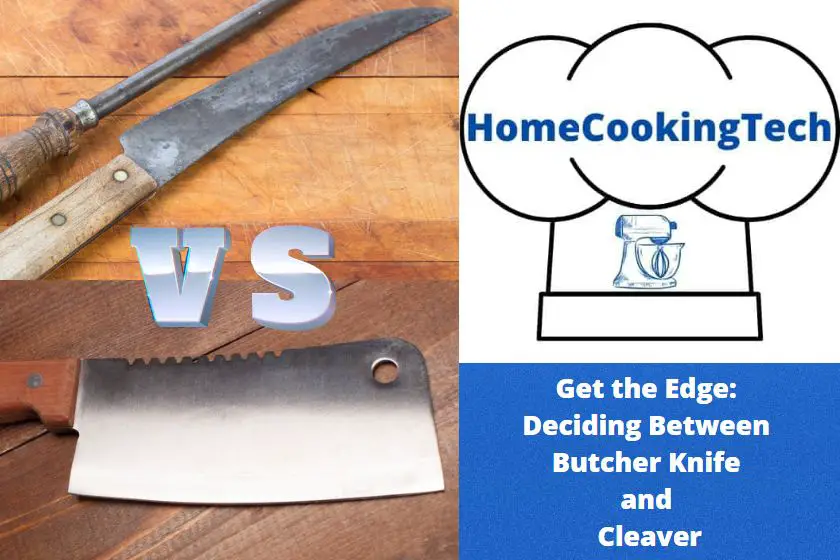When choosing the right kitchen knife, there are a few factors to consider. One crucial factor is the type of food you’ll be preparing. If you’re planning on doing a lot of meat prep, you’ll want to choose a butcher knife or a cleaver.
But which one is the best option for you?
In this blog post, we’ll be comparing butcher knives and cleavers. We’ll discuss the differences between the two types of knives and help you decide the best option for your needs.
Physical differences between a butcher knife and a cleaver
The most apparent difference between a butcher knife and a cleaver is the size and shape of the blade.
Butcher knives have long, thin blade that is ideal for slicing meat, while cleavers have a broad, thick blade that is better for chopping.
Another difference between these two types of knives is the handle. Butcher knives typically have a shorter handle that is easy to grip with one hand. Conversely, cleavers have a more extended handle better suited for two-handed use.
Finally, butcher knives are usually made from softer steel that is easier to sharpen. In comparison, cleavers are made from a more rigid type of steel that holds its edge for extended periods.
Butcher knife uses
Regarding kitchen knives, two of the most popular options are butcher knives and cleavers. Both can be incredibly useful for various tasks, but each has strengths and weaknesses.
Which one is right for you?
Butcher knives are great for general chopping and slicing. They can be used for everything from chopping vegetables to breaking down a chicken. They typically have a wide, rectangular blade between 6 and 10 inches long.
On the other hand, cleavers are designed for more heavy-duty tasks, like hacking through bone. They have a much thicker blade than a butcher knife and are usually between 8 and 14 inches long. The blade is also typically curved, which makes it easier to chop through rigid materials.
Cleaver uses
A butcher knife is a versatile tool that can be used for various tasks in the kitchen, from slicing meat and vegetables to chopping herbs and mincing garlic. But what sets a butcher knife apart from a cleaver, and when should you use each one?
A butcher knife is a long, sharp knife with a straight edge that is ideal for slicing and chopping. On the other hand, a cleaver is a heavy knife with a broad, thick blade that is great for hacking through tough cuts of meat.
So, when should you use a butcher knife vs. a cleaver?
A butcher knife is best if you need to slice or chop meat or vegetables.
A cleaver is better if you must hack through a tough cut of meat.
Advantages of a butcher knife
There are a few key advantages that a butcher knife has over a cleaver:
- Butcher knives tend to be thinner and sharper, which makes them better suited for slicing meat.
- Because they’re thinner, they’re also lighter and easier to handle.
- The curved blade of a butcher knife is ideal for cutting meat off the bone.
- Butcher knives are generally less expensive than cleavers.
Advantages of a cleaver
There are a few advantages that a cleaver has over a regular butcher knife:
- A cleaver is much heavier, which gives it more chopping power.
- The blade of a chopper is usually wider, which makes it easier to chop through large pieces of meat.
- The edge of a cleaver is often curved, which makes it easier to rock the blade back and forth to chop through tough meat.
- The handle of a chopper is usually more extended, which gives you more leverage when chopping.
Disadvantages of a butcher knife
While butcher knives are undoubtedly valuable tools, they do have some disadvantages:
- They are less versatile than cleavers. Cleavers can be used for various tasks, including chopping, mincing, and slicing. At the same time, butcher knives are only good for chopping and slicing.
- Butcher knives can be difficult to control, particularly for those with smaller hands. The large size and weight of the knife can make it unwieldy, and the sharpness of the blade can make it dangerous.
- Butcher knives are less durable than cleavers.
The edges are thinner and less sturdy, making them more likely to break or chip.
Disadvantages of a cleaver
While a cleaver is an excellent option for many people who are looking for a versatile and durable knife, there are a few disadvantages that you should be aware of before you purchase one.
- Cleavers can be heavy, making them challenging to use for extended periods.
- Additionally, the blade on a cleaver is typically quite wide, which can make it difficult to control when slicing through tough meats or vegetables.
- Finally, the sharpness of a cleaver’s blade can diminish quickly if it is not adequately cared for, so you will need to be vigilant about honing and sharpening it regularly.
Are butcher knives and cleavers also difficult to sharpen like pizza cutters?
Butcher knives and cleavers can be just as tricky to sharpen as pizza cutters. However, with the right tools and techniques, foolproof pizza cutter sharpening can be applied to these types of knives as well. It’s all about finding the right sharpening method to ensure a sharp and effective cutting tool.
Sharpening and maintenance tips for both knives
Keeping your butcher knife or cleaver sharp is essential, as with any knife. A sharp knife is a safe knife and will make your work in the kitchen more accessible and more efficient.
Here are a few tips for sharpening and maintaining your butcher knife or cleaver:
Use a honing rod or sharpening stone to keep the blade sharp. A honing rod is perfect for maintaining the edge of your butcher knife or cleaver between sharpening.
When sharpening, use a sharpening stone or diamond sharpener. First, find the angle you need to sharpen the blade at. For most knives, this will be around 20 degrees. Then, hold the blade at that angle and sharpen the blade with even and consistent strokes.
You must use a different sharpening technique if your butcher knife or cleaver has a serrated edge. First, find the angle you need to sharpen the blade at. For most serrated knives, this will be around 45 degrees. Then, use a sharpening stone or diamond sharpener to sharpen the blade with even and consistent strokes.
In conclusion, there is yet to be a clear winner regarding the butcher knife vs. cleaver debate. It depends on your preferences and what you will use the knife for. If you are looking for a general-purpose knife that can be used for various tasks, then the butcher knife is a good choice. If you are looking for a blade specifically designed for chopping, then the cleaver is the better option.
























